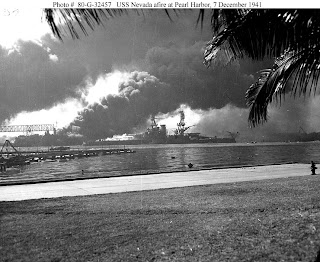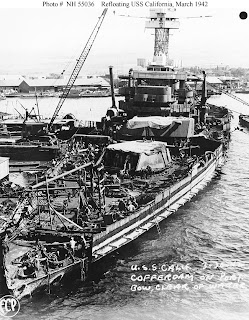Recently I was reminded that in those olden times when I was a young Lieutenant, we used to teach leadership in a course called, I think, "Leadership Management Effectiveness Training (LMET)" - in any event, one of the training aids - used to demonstrate the leadership syles of Douglas McGregor's
"THeory X and Theory Y" was the Air Force classic
"12 O'Clock High". It appears that
"12 O'Clock High" is perhaps still being used for this
purpose.
I don't think, however, that particular movie is the end all of good movies for learning about leadership, accountability, and management.
A few years ago I put up a list of 5 movies that are Navy themed that had merit in
"Sunday" Ship History: Best Navy Movies
...So, here's my list, in no particular order:
1) In Harm's Way. Except for the subplot involving Kirk Douglas's rape of a young nurse, an excellent movie. Patrick Oneal should not be missed as the smarmy PR hack/spy for the admiral ... RADM Torrey has been ordered in to work around. Later when Torrey saves that admiral some "face" it's a great moment in staff political warfare, which, in case you don't know is a big part of real warfare. Burgess Meredith is excellent as a reserve intel officer.
2) The Caine Mutiny. Remarkable movie, Fred McMurray really could act despite the roles he got later in life. Bogart is great as a mentally worn-out skipper whose wardroom fails him on  many levels while also being a sort of crazed screamer that some of us have served with. Have some frozen strawberries while you watch it.
many levels while also being a sort of crazed screamer that some of us have served with. Have some frozen strawberries while you watch it.
 3) Destination Tokyo. Almost enough to make you want to join the submarine force. Undersea heroics based on true events. Who wouldn't want to serve with the crew of Cary Grant's boat?
3) Destination Tokyo. Almost enough to make you want to join the submarine force. Undersea heroics based on true events. Who wouldn't want to serve with the crew of Cary Grant's boat?

4) Operation Petticoat. The other Cary Grant submarine movie - this time a comedy - and a pretty good one. Tony Curtis is great as the officer assigned to get spare parts "no questions asked" which was, back in the day (and perhaps today), a valuable skill set. Was there really a pink submarine in the Navy? Well, according to this site . . .

5) Mr. Roberts. On a ship traveling between "from Tedium to Apathy and back again, with an occasional side trip to Monotony." Once again the personality of the skipper, well played by James Cagney, comes to the fore (just as it does in real life). A reminder that not everyone who serves is at the tip of the spear, but it doesn't make them any less the sailors . . .
At the time (2009) I posted that list, it was not about leadership.
However, all 5 of those films should be in a "leadership film" collection for all hands.
In these modern times, the sub-plot of
In Harm's Way about the rape of a young nurse officer is not at all out of place, but a reminder that human beings are - human- and humans do stupid, selfish and cruel things to each other. The deft handling of a problem admiral by Admiral Halsey and the politics behind it all, including the staff "spy" - well, there are many lessons there.
The
Caine Mutiny? Leadership, as so emphatically pointed out at the end of the film, involves accepting responsibilty to help a struggling commander in the form of "loyalty up" - though undoubtly there is some point at which action must be taken. The question of exactly where that point is and how it should be taken could be the meat of a great class discussion.
Mr. Roberts has some of the same issues - with the addition of a martinet of a skipper out for himself at the expense of his crew tossed in. To this mix I would a non-Navy film -
Fort Apache described:
The rigid and arrogant Col. Owen Thursday, the new commander of Fort Apache, ignores the advice of Capt. York, his seasoned second in command, and ends up alienating his troops with his harsh treatment. Thursday is determined to boost his military honor and reputation by engaging and defeating the Apache warrior Cochise. ... Refusing to accept criticism or acknowledge any mistakes in his command, Thursday eventually puts his regiment in great danger culminating in a near-disaster for the troops.
Learning to listen to (and respect) your sub-ordinates ought to be part of every sailor's skill set, and this John Wayne/Henry Fonda/John Ford gem helps reinforce that point.
Along with
Fort Apache one of the other John Ford "cavalry" movies that has leadership lessons is
"She Wore a Yellow Ribbon". Among the lessons to be garnered from the film is the need to let junior officers gain experience both by observation and by taking the risks necessary for them to grow. There is also a sub-theme of the permanence of certain things -
Top Sergeant Quincannon: [on their upcoming retirement] The army will never be the same when we retire, sir.
Captain Nathan Brittles: The army is always the same. The sun and the moon change, but the army knows no seasons.
Substitute "Navy" in place of "Army" and it's still right. The underlying point, though, is that a key job of all military leader is to train our juniors so they will carry on the job. Training, even in combat, is our key mission.
By the way, you can download "She Wore a Yellow Ribbon" for free
here.
Another old movie that has leadership lessons is
The Cruel Sea, described as
The film portrays the conditions in which the Battle of the Atlantic was fought between the Royal Navy and Germany's U-boats. It is seen from the viewpoint of the British naval officers and seamen who served in convoy escorts. The film begins with a voice-over by Ericson (Jack Hawkins);
This is a story of the Battle of the Atlantic, the story of an ocean, two ships, and a handful of men. The men are the heroes; the heroines are the ships. The only villain is the sea, the cruel sea, that man has made more cruel...
Working an inexperienced crew into a team and struggling with inadequate resources while trying to keep sea lines of communication open . . . It's a Navy movie, here featuring the Royal Navy in a vital role, one that we neglect today at our peril. More than that, the decisions that weigh on a commanding officer are well-represented . . .
While there are probably many other movies that could mentioned (
The Enemy Below,
Das Boot,
Patton), these old movies have many moments that teach us about ourselves and about leading others.































